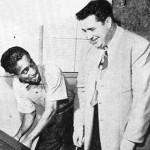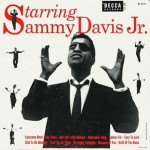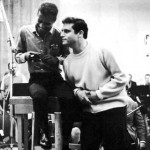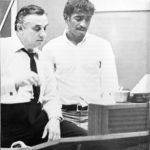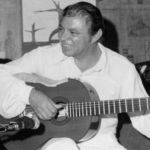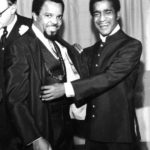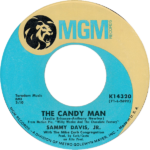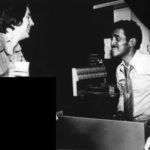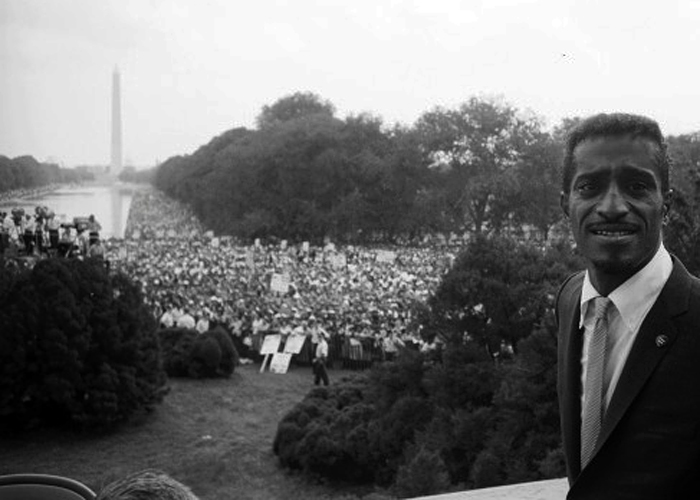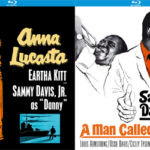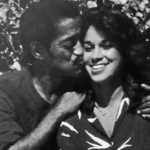Recording Career: Yes I Can!
By 1948, Sammy Davis, Jr. was making a name for himself as the drawcard member of the Will Mastin Trio, an opening act appearing in clubs and theatres around the United States. The Trio had become somewhat successful, opening for headliners such as Billie Holiday, Mickey Rooney and Frank Sinatra, but had yet to hit the big time. Sinatra had encouraged Sammy to sing in his own voice.
First cuts with Capitol Records
His first opportunity to do just that came after Capitol Records executive Dave Dexter heard Sammy on a radio broadcast from LA in late 1948. He asked a mutual friend, big-band drummer Jesse Price, to contact Sammy and he was soon signed to a 20-record deal – at $50 per side. Although the singles released were commercially unsuccessful (even resorting to releasing two singles under different pseudonyms – Charlie Green and Shorty Muggins), “The Way You Look Tonight” was chose by Metronome magazine as their ‘Record of the Year’ for 1949. The magazine also labeled Sammy the year’s ‘Most Outstanding New Personality’.
Sammy actually had some trouble finding his ‘own’ voice, and many of the recordings feature him adopting (or overtly mimicking) the vocal styles of popular singers of the day. In retrospect, Sammy considered that the arrangements and direction of Dave Cavanaugh were somewhat lacking, but it is clear that further work was necessary for him to develop his own style. Following their release on Capitol, the recordings remained largely unissued until the 1990s.
Signs with Decca Records
Four years after his experience with Capitol Records, Sammy had a much better command of his craft. While he was including more ‘straight’ songs into the Will Mastin Trio’s nightclub act, he was still primarily famous for his dancing and singing impressions. Hence, he was reluctant to sign another recording contract, fearing a repeat of his Capitol experience.
Decca’s Artists and Repertoire Executive Milt Gabler (Billy Crystal’s uncle) eventually convinced Davis to sign. He told him he could be a great singer in his own right, not just a great impressionist and dancer. When Billboard announced Davis’s signing in June 1954, it said that instead of featuring impressions, “Decca plans to put his own style on record”.
This time everything fell into place. His very first single, “Hey There”, was #1 on the Cash Box Record Charts for 8 weeks starting on 25 September, and remained on the charts for 23 weeks. A car accident the following month, in which Davis lost an eye, was not only a devastating physical blow but potentially a threat to his confidence and his career. Instead, Sammy’s legendary comeback at Ciro’s on 11 January 1955 saw him conquer any fears, and ride a wave of positive publicity. Decca quickly had another four sides recorded on 26 January, releasing the completed LP Starring Sammy Davis, Jr. on 18 April, with Sammy wearing his now-iconic eye patch on the front cover. By 11 June, it was the #1 album on the Billboard charts, and stayed there for 6 weeks.
The period 1957-1960 contains the artistic peak of Sammy’s recording stint with Decca Records. This includes a swinging album in the style of Ray Charles with the backing of the Count Basie band (minus Count Basie himself for contractual reasons), a memorable guitar-only album with Mundell Lowe, sessions featuring musical showstoppers arranged and conducted by Buddy Bregman, and two duet albums with Carmen McRae. Very little of this quality material has seen wide reissue (outside of Japan, at least).
As with Sammy’s 1954-1956 Decca output, there remains several unreleased recordings. Some of these still exist (they were on eBay at one point around 2005) but considering the difficulties suffered by the Davis Estate in recent decades it is unlikely they will see the light of day any time soon.
Joins Frank’s Reprise Records
The decision for Sammy to leave Decca Records at the end of 1960 was taken solely on the grounds that Frank Sinatra was leaving Capitol to create his own record label. Frank’s new label, Reprise Records, signed not only Sammy but similar artists such as Dean Martin, Bing Crosby, Rosemary Clooney, Count Basie, and Duke Ellington. Sammy signed his contract on the 1 September, 1960. With Frank looking out for the artists’ rights, the standard Reprise contract allowed for the rights to recorded masters to revert back to the artist after a short window but Davis actually signed these rights away – in the search for more short-term cashflow. Subsequent contracts with Reprise were signed on 1 July, 1962 and 23 September, 1963.
In his first few years at Reprise, Davis chose Marty Paich as a frequent collaborator, doubtless impressed by Paich’s work with Davis’ long-time friend Mel Tormé on Bethlehem and Verve. It was Paich’s ‘West Coast Jazz’-style approach that saw Sammy make some of the best recordings of his entire career during this time, most notably on one side of Sammy’s debut album on Reprise, The Wham Of Sam. Paich also arranged Sammy’s hit single “What Kind Of Fool Am I”, which was on the Billboard charts for 15 weeks in 1962, and was Grammy-nominated for Record of the Year.
Other highlights of the period 1961-1964 include standout albums of Broadway showstoppers, a collaboration with Sam Butera and The Witnesses, a live album recorded at the Cocoanut Grove, an album of songs composed by Mel Tormé, finally an official album with Count Basie and His Orchestra, and the cast recording from his second Broadway musical, Golden Boy.
With the musical finished, Davis returned to the Sands Hotel in May 1966. What followed over the next two months were three major highlights of his recording career. The first was a live double LP released of Sammy’s Sands performances titled That’s All, which serves as a time capsule of Sammy’s mid-60s prowess. The second was another live album from the Sands, The Sounds of ’66. This was a recording of an early morning show put on specially for performers from other hotels on the Las Vegas strip, with Sammy accompanied by Buddy Rich on drums and his big band. Both Sammy and Buddy are in swinging form.
Finally, in June and August, Davis recorded an album which many consider to be the apogee of his recording career, Sammy Davis, Jr. Sings, Laurindo Almeida Plays. Sammy sings with the sole accompaniment of Laurindo Almeida, a Brazilian classical guitarist, and the result is proof that, in the words of jazz critic Will Friedwald, “apart from everything else he could do, when all was said and done, he really was a great singer.”
However, this became less and less the case as the 60s wore on. He had another hit single in 1968 with “I Gotta Be Me”, which peaked at #11 and became a signature tune. But increasingly, Sammy’s Reprise recordings followed the downward trajectory of his career and his life at large. Caught up in the social upheaval of ‘Swinging London’, Sammy started to abuse booze and drugs, started wearing outrageous fashions, divorced his wife May Britt, and began unintentionally cultivating an image as an aging hipster. In the recording studio he attempted more R&B-styled material, with little success, and started lifting from the Blood, Sweat & Tears songbook.
Unsuccessful stint with Motown
It was clear by 1970 that Sammy Davis, Jr.’s music was not selling well on Reprise, and that this was unlikely to change. His manager Sy Marsh decided a change was necessary. Several factors led in the direction of Motown. For a start, Sammy was in the midst of an identity crisis regarding his relationship to the black community, and Motown was the biggest name in black music.
In addition, Sammy had come to know Motown’s founder Berry Gordy, Jr. through civil rights activities in the early 1960s, had been big supporters of Motown’s premier act The Supremes, and was acting as a mentor of sorts to a young Michael Jackson. It seemed like a good fit. In the words of Marsh, “the world’s number one record producer, who’s black, has signed the world’s greatest entertainer, who’s also black”. Part of an ambitious partnership announced in April 1970 was that a new label be created, for which Sammy would in future exclusively record. It was called Ecology, and would be distributed under the Motown umbrella.
The first move made by Motown was to release the masters Sammy had taken with him from two recording sessions he had self financed in October and November 1969. The material was largely covers of Blood, Sweat and Tears songs and other popular music of the day, and was titled Something For Everyone. The cover art was a case study in double entendre embarrassment, featuring Sammy in the midst of what looked like his own personal harem. The album was a commercial failure, which must have given Motown some pause.
Sammy now laid down new tracks for Motown, although most were still being produced by his former Reprise producer, Jimmy Bowen. One single was released on the new Ecology label. Marvin Gaye showed an interest in producing new tracks with an eye to releasing a ‘real’ Motown LP, later claiming to have spent $45,000 putting together demos that never reached Sammy. Motown engineers were also sent to record live concerts at Carnegie Hall in New York and the Now Grove in Los Angeles. (What happened to all these recordings is a mystery after they were sold at auction following Sammy’s death.)
After neither the first LP nor the Ecology single sold well, Motown declined to issue another LP. According to Sammy’s 1989 memoir Why Me?, Gordy told Marsh they didn’t think Sammy had “the Motown sound”. Marsh indicated that this wasn’t exactly a surprise. Using the threat of going public over Motown’s inability to make the Sammy situation work, he subsequently talked Gordy into severing the relationship and providing Sammy with all the unreleased material. And so the deal was reached in mid-1971 which saw Sammy leave Motown quietly.
Partners with Mike Curb and lands #1 single
Once the release from Motown was secured, Sammy’s manager, Sy Marsh, sought expressions of interest and eventually turned to a man keen to have Sammy on his roster – Mike Curb, of MGM Records. Curb had merged his label Sidewalk Records with MGM in 1969, becoming president of MGM Records at the age of 25. By 1971, Curb was leading MGM to profitability by steering it toward ‘middle of the road’ content; he was in the midst of successfully transforming The Osmonds from a variety show curiosity into a bona fide pop band, and had signed the likes of Lou Rawls, Steve Lawrence and Eydie Gormé. Curb had made waves in the industry for his stern anti-drug stance. Sammy signed on the dotted line, but was not a fan: “I hated the idea. Mike Curb? That cat’s square, white bread.”
Marsh’s first priority was to get Curb to release some outstanding Motown material, although Curb had his own ideas about what material might be commercially successful. Curb’s first idea was to pair Davis with his own chorus of young singers, The Mike Curb Congregation, on a song that the Congregation had already recorded solo, “The Candy Man”. The idea was totally unpalatable to Sammy, who had to be convinced to record it. After doing so he expressed his opinion that “This record is going straight into the toilet. Not just around the rim, but into the bowl, and it may just pull my whole career down with it.”
Instead, the very reverse occurred. “The Candy Man” became the most successful single of Davis’ career. After debuting on the Billboard Charts on 11 March 1972, the single remained there for 21 weeks, peaking at #1 on 10 June (where it remained for three weeks). MGM then appears to have taken some of the content brought over from Motown, added additional content recorded for MGM, and released the album Now in April 1972. It charted at #11.
Paired with a still-famous TV appearance on 19 February on All In The Family in which he kissed bigot Archie Bunker, “The Candy Man” briefly reinvigorated Sammy’s career. Despite this, live albums recorded for MGM were left unissued, and albums of in-studio material through 1973 and 1974 were largely failures – coming as they did during a period in which Sammy’s career faced multiple problems, some of a political nature, following his endorsement of President Richard Nixon for re-election. 1973 was the start of five years of heavy drug and alcohol addiction.
Sammy would find one more signature song, though, in the early 1970s – “Mr. Bojangles”. This was another song which Davis only very reluctantly began including in his act (perhaps fearing its autobiographical potential), and once it proved popular, he recorded it for MGM. It soon became the closing number to his act and remained closely identified with him for the rest of his career.
None of Sammy’s MGM LPs have been directly reissued on CD or for digital download and there also remains some unissued material. Many individual recordings have, however, made it onto compilation CDs.
Final appearances on vinyl
In the Billboard magazine edition of 30th November, 1974, it was announced that Sammy Davis, Jr. had left MGM Records and signed for 20th Century Records. But this was no splashy media fuss, as Sammy’s previous signings had been, and was instead more of a footnote buried on page 20. It was a difficult time for singers like Sammy on record. The same month, Warner Records’ President Joel Smith told Billboard “The record-buying audience is not buying that kind of legitimate pop singer. Each generation wants its own heroes … the people who love them in Las Vegas don’t buy records.”
Mike Curb (who had resigned from MGM in September 1973) continued to produce Sammy’s output throughout Sammy’s two-year stint with 20th Century, and then continued from late 1977 onward when Sammy’s few releases started to appear on Curb’s own label Warner/Curb. During his period with 20th Century, Sammy released only a handful of singles in the US, even though all of them charted on Billboard’s Adult Contemporary chart. Following a smash hit single in Europe with the theme song to the TV show Baretta, a couple of LPs were released in overseas markets only. Davis also released live recordings of concerts in Australia in 1977 and 1979.
In 1978, Sammy’s life began to turn around significantly, in part due to intervention from Frank Sinatra who was concerned about his substance abuse. In addition, he became involved in a new project for which sobriety was required – the musical Stop the World – I Want To Get Off. The production began rehearsals in April, toured from May to July, and opened on Broadway in August 1978. The cast album would become Davis’ second last LP release.
By 1982, Davis was back on top of his game and had become a respected headliner again, touring the world to his former acclaim. But his time as a recording artist had long since come and gone. His final full length LP, Closest Of Friends, a Country and Western album recorded in Nashville, was probably a labour of love for someone with a great affinity for all things Western (he had acted in several Westerns on film and television and in his hey-day he was said to be one of the two fastest draws in Hollywood).
This final album did, however, provide easily licensable material for a million cut-price CD producers to use in their phony Davis ‘Greatest Hits’ or ‘Rat Pack’ collections. This was a final indignity to a recording career that, until recently, has been almost criminally under-reissued.

